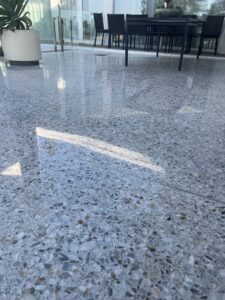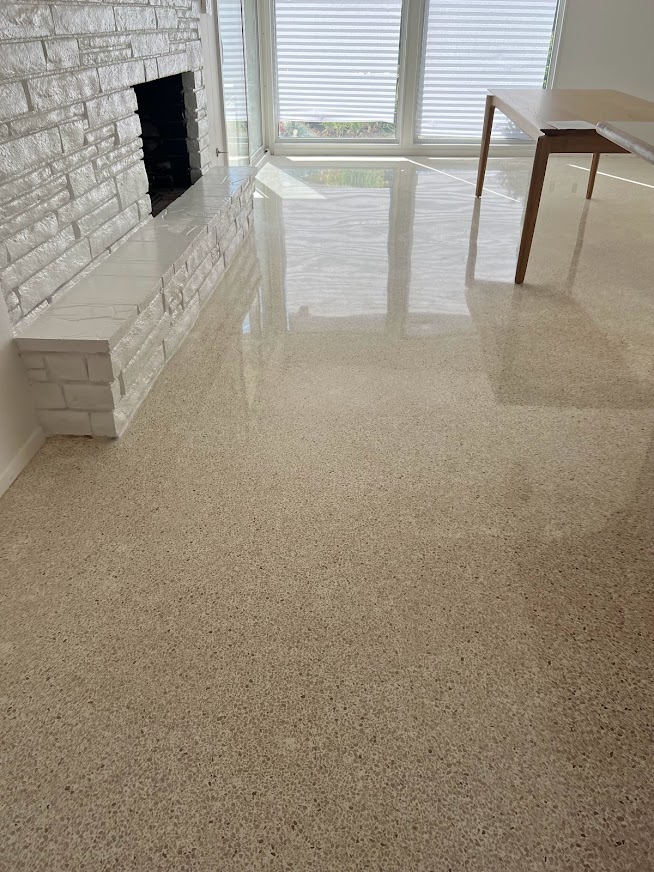Terrazzo Restoration Los Angeles
Bring the Elegance of Terrazzo Back to Life with JK Concrete Polishing
Terrazzo flooring enjoyed immense popularity in the early-mid 20th century thanks to its refined marble and granite aggregate aesthetic plus incredible durability properties, making it ideal for high-traffic commercial spaces.
While many decades-old Terrazzo floors and surfaces still exist, they often appear worn, drab, and dated from years of use and inadequate maintenance.
Fortunately, JK Concrete Polishing offers professional full-service Terrazzo restoration for historical building lobbies, municipal facilities, architecture landmarks, commercial retail developments, healthcare campuses, and more throughout the Greater Los Angeles region.
Using environmentally friendly and LEED-compliant processes paired with state-of-the-art equipment, we expertly transform lackluster Terrazzo back to their original sparkling glory and beyond.
The Terrazzo Repair and Restoration Process
Our expert Terrazzo technicians carefully evaluate each aging Terrazzo installation, noting current conditions plus desired restoration outcomes before tailoring a specialized process.
After protecting surrounding areas from dust and debris, initial preparation work commences.
It may involve patching cracks, replacing damaged areas, and deep, intensive cleaning to remove stains, salts, oils, and residue.
Next, large weighted concrete Grinders are used.
They have various grit levels of bonded diamond abrasives to grind away scratches meticulously.
This opens microscopic pores again and exposes vivid colors and gorgeous aggregate stones.
As the grinding and honing stages progress, increasing clarity, reflectivity, and light play return to the Terrazzo.
At the same time, a completely new profile emerges from the once lackluster floor or wall application.
The final polishing and buffing stages using crystallization polish allow the restored Terrazzo to sparkle like new, often with amplified color depth and stone contrasts over the original.
Various sheen levels are possible, from ultra high-gloss to more subdued satin finishes.
Once grinding and honing eliminate floor damage and aging discoloration, sealing processes protect the renewed.
Terrazzo while locking in dazzling brilliance.
Rejuvenated mid-century Terrazzo floors exude a luxurious feel-good factor underfoot thanks to their smooth, excellent, dense profiles.
Green-Friendly Terrazzo Restoration Diamond Grinding and Polishing
Unlike messy chemical stripping methods, JK Concrete Polishing leverages modern technology and engineering controls for cleaner, lower-impact
Terrazzo restoration processes.
Dust containment systems vacuum 99% particulate during diamond honing while final auto-scrubbing removes slurry water safely.
This is better for human health than solvent fumes or chemicals, and our low ecological footprint processes promote USGBC LEED environmentally sustainable certification for most building projects.
Terrazzo also qualifies as locally sourced low-VOC flooring material for valuable LEED credits.
Terrazzo Floor Service and More
While Terrazzo floor restoration garners tremendous WOWs, few realize what an excellent multipurpose floor it is.
Terrazzo makes it, too. Beyond walls, stair treads, doorway borders, and floor inlays consider specifying durable Terrazzo for:
– Backsplashes
– Vanities
– Tables
– Benches
– Showers
– Outdoor Furnishings
– Pool copings
– Fountains
– Murals and Decor
With over 50 aggregate colors and recycling capabilities, Terrazzo offers design versatility comparable to natural stone, quartz, or concrete but with thinner application possibilities, plus 80% reused content from previous installations if desired.
Radiant heating systems also easily integrate with Terrazzo floors thanks to the material’s conductive thermal mass properties.
Terrazzo does it all with unrivaled longevity, but periodic professional restoration is critical to maintaining the life cycle.
Terrazzo Restoration Cost To Hone Free Quote
Owners investing in Terrazzo restorations also frequently utilize JK Concrete Polishing for stained, polished, overlaid, or etched concrete floor services throughout the rest of their commercial buildings or HOA properties.
With Terrazzo costs averaging $ 30-$40 per square foot installed, restored concrete makes an excellent coordinated flooring solution in surrounding spaces at just $2-$5 per square foot.
Consistent flooring appearance promotes better wayfinding and accessibility compliance, too.
As leaders in concrete corrections, upgrades, and maintenance,
JK Concrete Polishing promises reliably beautiful, slip-resistant flooring installations that stand the test of time with more accessible upkeep costs compared to most flooring options.
Expand possibilities by checking out our online portfolio, which showcases stunning polished concrete floors in gloss, satin, and matte finishes.
Terrazzo Faqs Stone Expert
What is terrazzo exactly?
Terrazzo is a composite flooring made of marble, quartz, granite, glass, or other suitable chips embedded in a poured cement matrix, epoxy resin, or another binding agent.
What’s the typical cost per square foot of terrazzo?
Terrazzo costs between $30-40 per square foot installed on average.
Factors impacting price include matrix poured, amount of customization, and labor for specialty designs.
How is traditional terrazzo installed?
After pouring a concrete base, the terrazzo mixture is poured and pressed smoothly using a weighted roller.
Once dried, it is mechanically ground and polished to expose the decorative chips.
Is terrazzo suitable for exterior use?
Yes, exterior grade terrazzo mixes hold up beautifully on sidewalks, patios, plazas, and pool copings exposed to environmental conditions with appropriate slip-resistant textures and sealers.

What is the average lifespan of a terrazzo?
Properly installed and maintained, commercial and residential terrazzo should never need replacement, lasting 50+ years with occasional restoration and re-polishing over time. Some historic terrazzo has been in use for nearly 100 years.
How often does terrazzo restoration polishing need to be repeated?
Terrazzo should be professionally restored and re-polished by sanding and honing down to expose fresh floor and colors every three years or as needed based on wear exposure and desired gloss levels.
Can you pour new terrazzo over old existing terrazzo?
In many cases, yes. Some demolition down to base slab concrete may be required first, but re-pouring the new terrazzo’s 1⁄4 inch to half inch thickness can cover the existing in suitable conditions.
Does terrazzo flooring require waxing or sealing?
Sealers help protect terrazzo floors from etching. Buffing with long-lasting wax finishes also provides a protective layer plus enhances reflective shine. Reapply every 1-2 years.
Is the radiant heating system compatible with the terrazzo?
Yes, terrazzo conducts, and stores heat energy effectively from subfloor radiant heating grids, piping, or cables, thanks to its dense mass.
This releases gentle warmth steadily once the heat source is turned off.
Can you match the new terrazzo installation to blend with the old existing area?
Terrazzo technicians can recreate near-precise matches to age, style, textures, and more by sourcing original mix formulas from historical records or evaluating the previous work visually if records were not archived.
Does Terrazzo have any sustainability benefits?
Yes, terrazzo can contain high recycled content like crushed glass, marble chips, or granite remnants diverted from landfills.
Cementitious binders draw carbonation from the air during installation, also lowering CO2 emissions long-term.
Restored Terrazzo Floors
Professional full-service terrazzo restoration can transform lackluster terrazzo floors back to their original glory.
Strategic sanding and honing with specialty equipment remove years of grime exposure plus light surface erosion, revealing vibrant colors and artistic aggregate designs previously hidden under years of waxy buildup or residual adhesive.
Further buffing and sealing renew terrazzo, delivering like-new visual brilliance with a hydrated surface resistant to scratching or etching despite heavy traffic patterns.
Epoxy Terrazzo Vs. Cement Terrazzo
“Welcome to JK Concrete Polishing, where expertise meets craftsmanship.
As a leading terrazzo floor specialist in Los Angeles, we take pride in delivering unparalleled terrazzo restoration and repair services.
With years of experience, our commitment to excellence ensures that your floor will shine with renewed splendor.
Choose us for the perfect blend of tradition and innovation in terrazzo care.”
Terrazzo is a decorative flooring system that has been around since the 1500s.
It is made by embedding small pieces of marble or granite in mortar, followed by polishing.
There are two main types of terrazzo: cement-based terrazzo and epoxy terrazzo, each with its own characteristics and treatment methods.
Cement Based Terrazzo
Cement-based terrazzo is one of the oldest decorative flooring systems.
It is a mosaic-like floor topping made by embedding small pieces of marble or granite in mortar, followed by polishing.This type of terrazzo is highly prized for its timeless beauty. However, it must be applied at 2 to 3 inches in thickness, making it a more substantial flooring option than Concrete Network.
Epoxy Terrazzo
An epoxy Terrazzo is a newer type of terrazzo that offers many benefits.
It is a poured-in-place topping for concrete substrates that goes on at a thickness of only 1/4 to 3/8 inch, making it thinner and lighter than traditional terrazzo.
The epoxy resin matrix can be pigmented to achieve an unlimited spectrum of colors, and it can accommodate a wider variety of richly colored aggregates, including chips of marble or granite, recycled glass, mother of pearl, and various synthetic materials.
An epoxy terrazzo offers outstanding durability and wear, making it tough enough for use in high-traffic commercial and industrial environments.
Because the binder is 100% epoxy, the finished floor surface provides more excellent resiliency, chemical resistance, compressive strength, and flexibility than cement-based systems.
Treatment of Terrazzo Floors
The treatment of terrazzo floors depends on the type of terrazzo used.
Regular cleaning and periodic re-sealing are typically required for cement-based terrazzo to maintain its appearance and durability.
It’s also important to promptly address any chips or cracks to prevent further damage.
This terrazzo, on the other hand, requires less maintenance due to its non-absorbency.
It is incredibly long-wearing and has the lowest life-cycle cost of any hard floor surface.
Because epoxy terrazzo surfaces are smooth, seamless, and nonporous, they are straightforward to clean and won’t harbor mold or mildew growth.
They also resist staining caused by chemical, oil, and grease spills.
Most manufacturers recommend washing the surface with a neutral cleaner and rinsing.
In conclusion, cement-based and epoxy terrazzo offers unique benefits and aesthetic appeal.
The choice between the two often depends on the specific needs and preferences of the user, including factors like budget, desired aesthetics, and maintenance requirements.
Terrazzo Restoration Process
Rest: Bring Your Floors Back to Life with JK Concrete Polishing Los Angeles
Terrazzo is a beautiful, durable flooring material that lasts many years. However, terrazzo can become stained, damaged, or dull over time. If your terrazzo floors look tired, JK Concrete Polishing Los Angeles can help you restore them to their former glory.
JK Concrete Polishing Los Angeles is a leading terrazzo restoration company in Los Angeles.
We have over 20 years of experience in the industry, and we use the latest techniques to restore terrazzo floors. We can remove stains, repair damage, and polish your floors to a high shine.
We offer a variety of terrazzo restoration services, including:
- Stain removal
- Crack repair
- Chip repair
- Polishing
- Sealing
We can also customize our services to meet your specific needs.
For example, if you have a terrazzo floor with a unique design, we can restore it to its original appearance.
JK Concrete Polishing Los Angeles is committed to providing our customers with the highest quality terrazzo restoration services. We use only the finest materials and techniques and guarantee our work.
If you’re looking for a terrazzo restoration company in Los Angeles, contact JK Concrete Polishing Los Angeles today. We’ll help you bring your floors back to life.
Why is Terrazzo Maintenance Important?
Terrazzo floors are unique and beautiful, but they also require proper maintenance to stay that way. Here are some reasons why terrazzo maintenance is so essential:
Protection
Regular maintenance can protect your terrazzo floors from damage, including scratches, stains, and wear and tear. It can also help prevent the need for costly repairs down the line.
Longevity
Proper maintenance can help extend the lifespan of your terrazzo floors, so you can enjoy them for years to come.
Aesthetics
Terrazzo floors are known for their beauty and unique appearance. Regular maintenance can help preserve their appearance and keep them looking their best.

